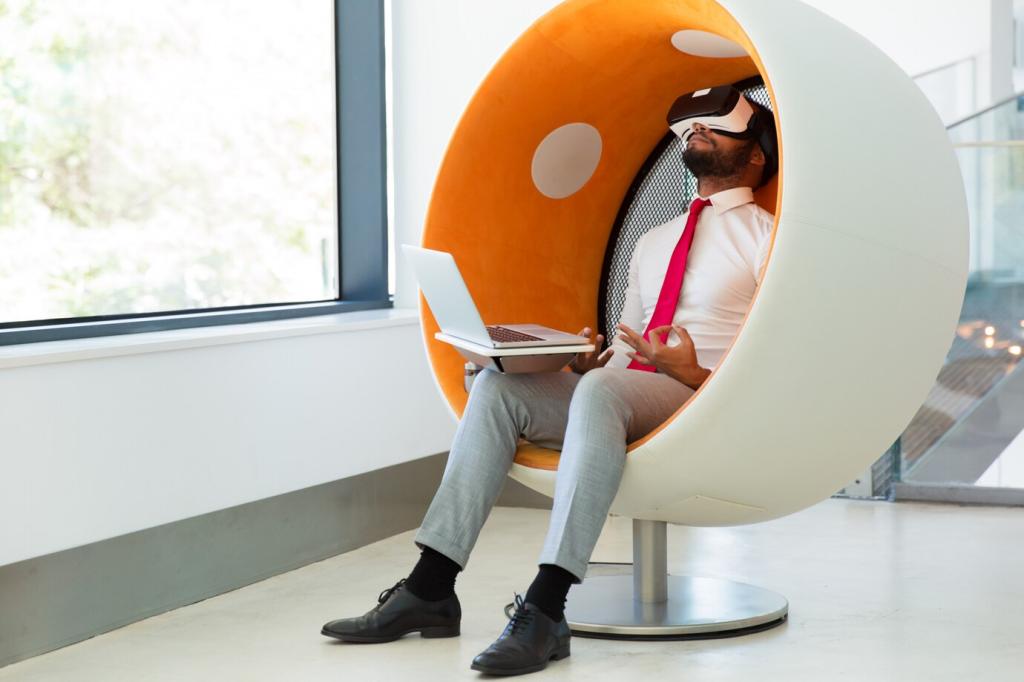Stand Smarter: Ergonomic Considerations for Standing Desks
Chosen theme: Ergonomic Considerations for Standing Desks. Welcome to a friendly guide that blends research, real-world stories, and practical tweaks so you can feel energized, comfortable, and productive every time you rise to work.
Finding Your Ideal Standing Desk Height
Aim for elbows at roughly ninety degrees and keep wrists straight, not cocked upwards. This reduces pressure on tendons, promotes healthy circulation, and keeps shoulders relaxed, helping you work longer without tingling, numbness, or nagging forearm fatigue.

Dynamic Posture: Move More, Hurt Less

Every twenty to thirty minutes, take forty-five seconds to roll shoulders, shift weight, and stretch calves. Small movements stimulate blood flow, refresh attention, and prevent the creeping stiffness that builds when you stand like a statue for too long.
Keyboard and Mouse Setup for Standing Success
Neutral Tilt and Split Keyboards
Consider a negative tilt so the keyboard slopes away from you, helping wrists stay straight. A split design can reduce ulnar deviation, aligning forearms and hands, which decreases strain on the carpal tunnel during longer, focused sessions.
Pointing Devices That Reduce Reach
Keep your mouse close to the keyboard’s home row. Trackballs and vertical mice can limit wrist deviation and shoulder abduction, especially when standing. The shorter the reach, the less cumulative stress builds in your upper arm and neck.
Cable Management for Smooth Movement
Secure cables so they never snag while you alternate positions. A gentle slack loop prevents accidental tugs that yank your mouse or keyboard and subtly force awkward postures. Share your cable wins in the comments to help others tidy up.
Sit-Stand Scheduling: A Transition Plan That Feels Natural
Start with twenty minutes standing and forty minutes sitting per hour for days one through three. Gradually increase standing by five to ten minutes every few days, ensuring you never trade comfort for ambition. Keep a simple journal to track progress.
Sit-Stand Scheduling: A Transition Plan That Feels Natural
Use phone reminders or a Pomodoro timer to switch positions before fatigue sets in. Gentle nudges beat heroic marathons. Consistency creates habits, and habits protect your back, hips, and focus long after novelty wears off.
Sit-Stand Scheduling: A Transition Plan That Feels Natural
If calves burn or lower back tightens, sit before discomfort escalates. Ergonomics respects individual thresholds. Share your sweet-spot intervals so readers can compare experiences, discover patterns, and build a routine that feels sustainably energizing.


Footwear, Flooring, and Support
Choose shoes with mild arch support and shock absorption, avoiding hard, unsupportive soles. Rotating pairs across the week can vary pressure points and keep tissues happier. If you prefer minimalist shoes, increase standing time more gradually.
Footwear, Flooring, and Support
Pick a mat that won’t compress into a pancake by noon. Medium firmness, textured grip, and beveled edges reduce tripping risk. Bonus points for a surface that encourages subtle foot movement, keeping your ankles and calves quietly active.

A Real-World Story: From Back Twinges to Daily Wins
Before: Pain and Guesswork
A software lead reported mid-afternoon lower back twinges and wrist tingling after adopting a standing desk overnight. Without a plan, they locked knees, stared downward, and powered through fatigue, assuming discomfort was inevitable for ambitious professionals.
The Change: Measured Adjustments
They raised the monitor to eye level, set elbows near ninety degrees, added a medium-firm mat, and followed twenty-five minutes standing, thirty-five sitting. Inside a week, they learned to shift feet, relax shoulders, and respect early fatigue signals.
After: Results and Reflection
Within three weeks, wrist tingling vanished and back discomfort dropped dramatically. Energy felt steadier across long sprints. They now share weekly tweaks with teammates. Join the conversation below, and subscribe for more practical, human-centered ergonomic insights.
